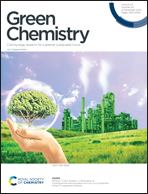The active ruthenium (101) crystal plane selectively exposed by in situ metal hyperaccumulation on a living plant for overall water splitting†
Abstract
Biomass derived catalysts as economical and eco-friendly carbon-based materials can address the challenge of ever-increasing energy demand and are conducive to the global carbon-neutral policy. However, the conventional metal doping normally occurred after the carbonization of biomass, usually resulting in uneven metal distribution. Here we report a novel in situ metal hyperaccumulation method on a live plant to obtain ruthenium nanoparticle doped biomass carbon (Ru@BS) as a bifunctional electrocatalyst toward overall water splitting. Specifically, the uniformly distributed Ru nanoparticles on Ru@BS dominantly exposed the (101) crystal plane with the typical HCP crystalline structure. The as-prepared Ru@BS-5 catalysts exhibit a superior catalytic activity, outperforming the state-of-the-art commercial platinum and iridium catalysts for the hydrogen evolution reaction (HER) and oxygen evolution reaction (OER) with an overpotential of 40 mV and 370 mV at a current density of 10 mA cm−2. Furthermore, the bifunctional catalyst was designed for overall water splitting, achieving a current density of 10 mA cm−2 at a voltage of 1.56 V. The first principles calculations revealed that the exposed (101) crystal plane presented a low ΔG of 0.09 eV for the HER process, comparable to the commercial Pt/C, contributing to the high activity of Ru@BS-5.



 Please wait while we load your content...
Please wait while we load your content...